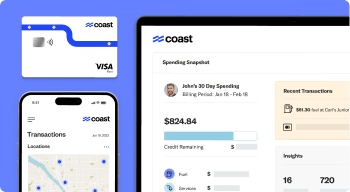Operating a successful fleet of any size ultimately comes down to controlling costs. A well-running fleet is essential to providing services to your customers in the field — and cost management is an underrated aspect to running an efficient fleet.
If you neglect your budget for too long, spending can get away from you and may create bad habits that can cause problems later on.
In this article, we discuss tips for better fleet cost management so your business can work toward saving money rather than watching it come in and go right back out.
Tips For Better Fleet Cost Management

1) Conduct A Cost Analysis
You can’t control what you don’t measure, so take the time to conduct a cost analysis, including such metrics as total cost of ownership and cost per mile for each vehicle.
Total Cost Of Ownership
Calculate total cost of ownership for each fleet vehicle with the following formula:
Total Cost Of Ownership = Fixed Vehicle Costs + Variable Vehicle Costs
When using this formula, be sure to specify the time period you’re examining — you can do it for any length of time you choose — and make sure that none of the costs fall outside that range.
For example, let’s say that you want to see what the total cost of ownership for one of your newer work vans is (Vehicle A).
First, you would add up all the fixed vehicle costs (e.g., payments, insurance, licenses, and permits) you pay in one month for Vehicle A. In this example, we’ll say it’s $2,000.
Next, you would add up all the variable vehicle costs (e.g., fuel, tolls, and maintenance) you pay in one month for Vehicle A. In this example, we’ll say it’s $5,000.
Finally, plug those numbers into the equation, and you get:
Total Cost Of Ownership = $2,000 + $5,000
Total Cost Of Ownership = $7,000 per month
Key Takeaway: You can customize the equation to reveal your expenses for any amount of time you choose (e.g., three months, four months, six months, 12 months) by adding together the fixed and variable vehicle costs for that period of time.
Vehicle Cost Per Mile
After you calculate the total cost of ownership, the next metric in your cost analysis is the vehicle cost per mile.
The formula is:
Vehicle Cost Per Mile = Total Cost Of Ownership / Total Miles Driven
Continuing with the example from the previous section, you examine your records to discover that Vehicle A drove a total of 10,000 miles last month.
Plug that number into the equation along with the total cost of ownership, and you get:
Vehicle Cost Per Mile = $7,000 / 10,000 miles
Vehicle Cost Per Mile = $0.70 per mile
Armed with this data, you now have a benchmark against which to measure the success or failure of the other tips on this list.
2) Research Buying Vs. Leasing Vs. Renting
Next to fuel costs, vehicle acquisition can be one of the biggest pinch points when it comes to fleet cost management.
Regardless of the type of vehicles your business uses, you’ll be faced with three options: buying, leasing, and renting.
Buying (a.k.a. ownership) involves spending business funds upfront to purchase a vehicle.
This, then, comes with the responsibility of keeping the vehicle in good working order, maintaining government-mandated paperwork, ensuring compliance, and verifying that repairs are done correctly and in a timely manner.
Leasing involves paying another business to use their vehicles for a specified period of time.
In a leasing situation, Company 1 (the owner of the vehicles) and Company 2 (your business) enter into a contract whereby Company 1 charges Company 2 a monthly or yearly fee in exchange for the use of certain cars, trucks, vans, and/or SUVs.
Leasing may be the right option for your business if you don’t have the capital to purchase a vehicle outright.
Renting is similar to leasing, but the former is structured more toward the short term, while the latter is structured more toward the long term.
For example, a lease contract may last a year or longer, while a rental contract may only last a week or two.
Renting is a viable option if you’re going to need a vehicle you don’t already have access to — a bulldozer, for example — for only a few days or weeks.
You’ll save money in the long run by only paying for what you need at the time.
3) Lower Fuel Expenses

As gas and diesel prices continue to rise, lowering common fuel expenses is one of the most important steps you can take in your fleet cost management efforts.
Here are some ideas that may help you cut back on your fuel spending.
Skip The More Expensive Grades
Fuel typically comes in a variety of different grades and at a variety of different prices.
Your business can get a discount right off the bat by skipping the more expensive grades and filling the tank with the lowest-priced option that works for your commercial vehicles (e.g., 87 octane for gas-powered vehicles and Diesel #2 for diesel-powered vehicles).
While the higher grades do offer some benefits in certain situations — Diesel #1 performs better in cold temperatures, for example — you’ll be paying extra for something you don’t necessarily need.
Use An App To Find The Best Price Nearby
Avoid paying more than necessary when it comes time to fill up by using an app to find the cheapest price along the driver’s route.
In conjunction with that, train your drivers to:
- Look across state lines where the price may be significantly less
- Avoid filling up at stations just off the highway where the prices tend to be higher
- Fill up before the tank is empty so they’re not forced to stop at the closest station
Fill Up Early In The Week
Fuel prices are sometimes lower early in the week after the weekend rush.
Encouraging drivers to fill up at the start of the week instead of the end of the week may provide a significant fuel discount for your fleet.
Depending on workload and distance traveled, filling up early in the week may not always be possible. But doing so even once or twice a month can significantly reduce your fleet’s total fuel expenses over the long term.
4) Increase Miles Per Gallon

Another method for improving fleet cost management is finding ways to increase the miles per gallon (MPG) your vehicles get while on the road.
Not sure how to do this? Here are some useful suggestions.
- Lighten your vehicles by removing unused tools and cargo
- Maintain correct tire pressure at all times
- Reduce idle time
- Invest in aerodynamic modifications
- Improve driver behavior (e.g., accelerating slowly, maintaining a constant speed whenever possible, coasting more, etc.)
5) Reduce Miles Traveled
Reducing miles traveled can be difficult to maintain but may produce substantial savings if done correctly.
Try cutting back on trips with little business relevance and using technology to:
- Plan the shortest route
- Group nearby stops together
- Prevent extra driving for in-person meetings
6) Improve Your Fleet Maintenance Program
As your vehicles age, fleet maintenance costs can skyrocket.
But, with the right program in place — including preventative maintenance and pre– and post-trip inspections — you can extend the life of your vehicles and reduce the expense involved in keeping them on the road.
7) Use Smaller Vehicles

Smaller vehicles have a tendency to cost less to operate because they get better mileage, use less fuel, and experience less wear and tear because they aren’t being pushed to haul heavy loads all the time.
For example, do your field service technicians absolutely need the cargo capacity and hauling power of a pickup truck? Or, could they fit their necessary tools in an SUV or minivan that comes with a lower cost of operation?
8) Field The Right Size Fleet
Fielding the right size fleet is another great way to control and reduce costs.
Examine your fleet, and you may discover that you have surplus vehicles — both in service and out of service — that you can sell to reduce total business expenses, including fuel, registration, insurance, maintenance, and repair.
9) Develop A Vehicle Replacement Plan
No matter how nicely you treat them, all vehicles wear out over time. When they do, they can become more expensive to operate.
Don’t let older vehicles be a drain on your bank account.
Develop a vehicle replacement plan so you know when it’s time to sell or scrap an asset for a newer model.
Coast Can Help With Fleet Cost Management

When it comes to fleet cost management, controlling fuel expenses is one of the most important steps you can take. The Coast fleet and fuel card is open loop (which means that it’s universally accepted and can be used anywhere you’d use a Visa card).
The Coast card also comes with advanced spending controls and provides access to an online expense management platform that empowers you with real-time information related to your fleet.
For more information on how Coast can help you manage your fleet better, visit CoastPay.com today.


